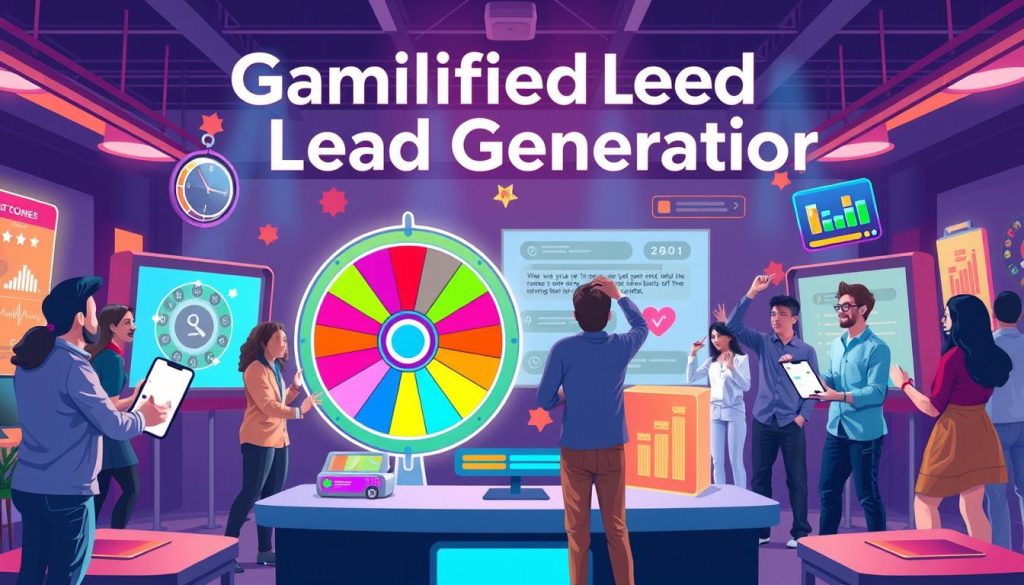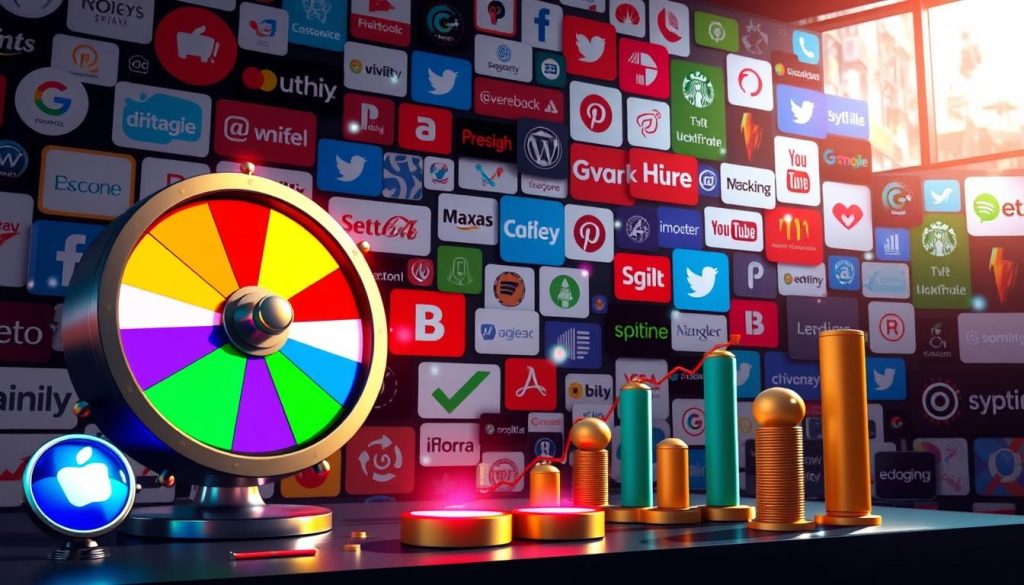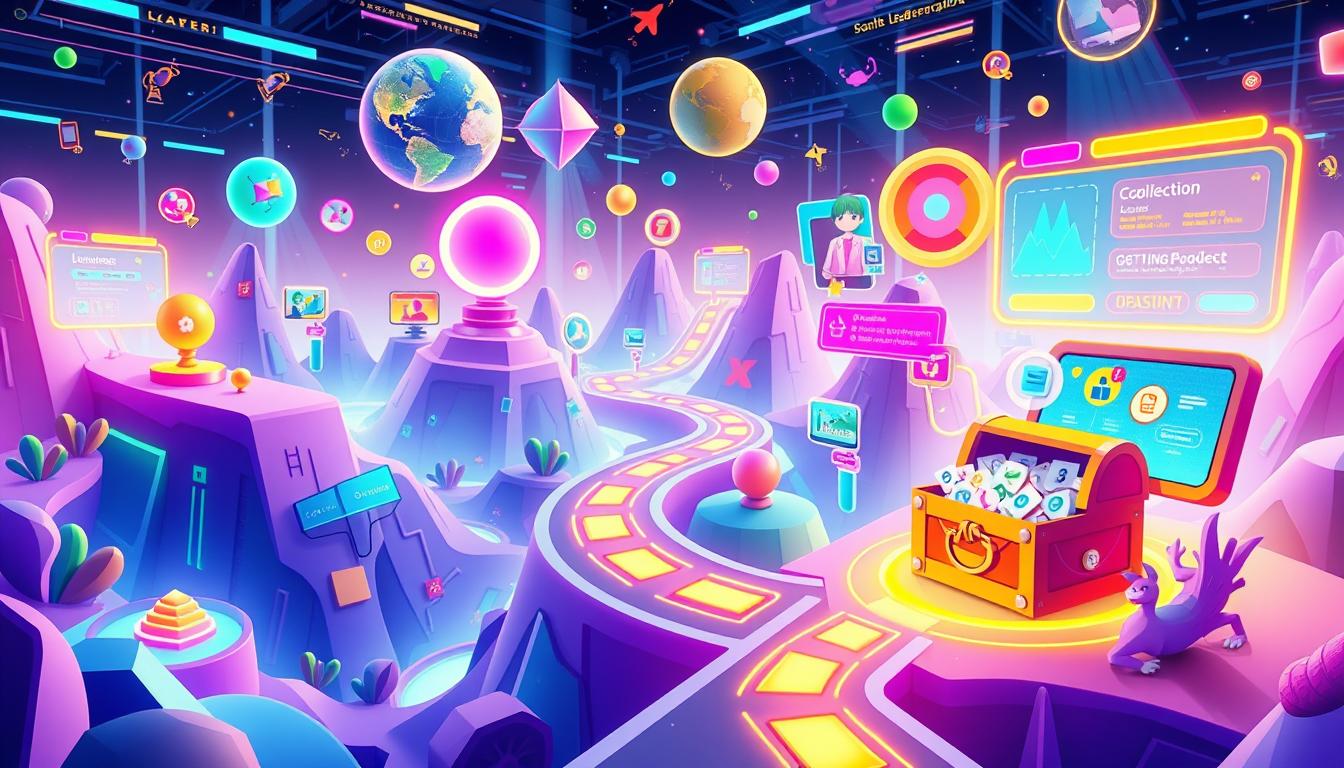In today’s fast-paced marketing world, companies are always looking for new ways to grab their audience’s attention. Gamified lead generation is a game-changer. It mixes game elements with traditional lead capture to engage customers and get quality leads.
Gamification works by using what we know about human psychology. It makes experiences fun, interactive, and rewarding. This way, businesses build stronger connections with their audience, get more people involved, and see better results. From interactive lead capture to incentivized conversions and loyalty programs, gamified lead generation is all about keeping customers engaged and interested.
Key Takeaways
- Gamified lead generation uses game mechanics to boost customer engagement and conversions.
- Adding interactive elements and rewards to lead capture can really up the conversion rates.
- Gamification taps into human psychology and motivation, creating stronger bonds between businesses and their audience.
- Creating immersive experiences and telling stories are key to successful gamified lead generation campaigns.
- Setting clear goals, using feedback loops, and analyzing behavior are vital for improving gamified lead generation efforts.
Engage and Convert: Why Gamified Lead Generation Works
Gamification is a key strategy in Gamification Marketing and Interactive Lead Capture. It uses the human desire for achievement and fun. This approach engages customers and boosts conversion rates.
The psychology of gamification taps into our drive to achieve and get rewards. Gamified lead capture offers clear goals and instant feedback. This creates a positive cycle that keeps users coming back.
Also, gamified experiences are fun and memorable. They use elements like leaderboards and challenges. This makes the lead generation process exciting and builds brand loyalty.
The why gamified lead generation works is its mix of marketing goals and human desires. It offers a rewarding experience. This leads to better engagement, higher conversion rates, and stronger customer relationships.
| Key Benefits of Gamified Lead Generation | Metrics and Outcomes |
|---|---|
|
|
“Gamification is not about turning your website into a video game. It’s about using game design thinking to solve problems and meet objectives.”
The Psychology of Gamification in Marketing
Gamification is a key tool in marketing, using psychology to grab and keep customers’ attention. It digs deep into what makes people tick, using their natural wants and needs.
Tapping into Human Motivation
Gamification marketing uses what people naturally want, like achieving, being free, and connecting with others. It adds game-like features to lead generation. This makes customers want to get involved and connect with brands.
Leveraging the Power of Play
Play is at the core of good gamification. It makes customers enjoy, compete, and reach goals in a fun way. This not only makes lead capture better but also builds loyalty and keeps customers coming back.
The heart of gamification in marketing is knowing and using what drives humans. By matching lead generation with these principles, companies can make experiences that turn visitors into loyal fans.
| Key Human Motivations | How Gamification Taps Into Them |
|---|---|
| Desire for Achievement | Incorporating challenges, goals, and rewards to satisfy the need for accomplishment |
| Need for Autonomy | Providing users with a sense of control and choice within the lead generation process |
| Craving for Social Connection | Enabling social interaction, competition, and collaboration through game-like features |
“Gamification is the application of game-design elements and game principles in non-game contexts. It taps into fundamental human motivations and behaviors to drive engagement and desired outcomes.”
Marketers who get gamification can make lead generation that grabs and keeps customers. This leads to business growth and success.
Interactive Lead Capture Strategies
Creating effective Interactive Lead Capture strategies is key for businesses. They help engage the audience and turn leads into loyal customers. Gamification makes it possible to create fun experiences that also capture valuable customer data.
Quizzes and surveys are popular for capturing leads. They entertain users and ask for their contact info for personalized results or exclusive content. When done right, they offer a fun and memorable experience.
Contests and challenges are also great for capturing leads. They offer prizes or benefits to encourage users to share their info. These can be anything from design challenges to brand trivia, making users excited and engaged.
| Interactive Lead Capture Tactic | Key Benefits |
|---|---|
| Quizzes and Surveys |
|
| Contests and Challenges |
|
By using these Interactive Lead Capture tactics, businesses can create Immersive User Experiences. These experiences captivate the audience, generate quality leads, and drive business growth.
Designing Immersive User Experiences
In the world of gamified lead generation, the key to capturing and retaining user attention lies in creating truly immersive experiences. By blending engaging storytelling, narrative elements, and multimodal engagement techniques, marketers can craft lead capture processes that captivate their audience and drive meaningful conversions.
Storytelling and Narrative Elements
Effective lead generation campaigns often incorporate compelling narratives that resonate with the target audience. By weaving a captivating story, brands can tap into the user’s emotions and imagination, making the lead capture process more memorable and impactful. From dynamic character arcs to intricate plot twists, thoughtfully crafted narratives can transform a typical lead form into an immersive journey that users are eager to experience.
Multimodal Engagement Techniques
To further enhance the user experience, marketers can leverage multimodal engagement techniques that cater to a variety of sensory preferences. The integration of visuals, audio, and interactive elements can create a more dynamic and engaging lead capture process. For example, incorporating vibrant graphics, immersive sound effects, and interactive challenges can stimulate the user’s senses and foster a deeper connection with the brand.
By designing Immersive User Experiences that captivate the user’s imagination and senses, marketers can effectively drive Incentivized Conversions through gamified lead generation strategies.
Incentivized Conversions: Rewards and Loyalty Programs
In the world of gamified lead generation, using incentives and loyalty programs is key. These strategies help drive Incentivized Conversions. By offering rewards, points, badges, and more, marketers can keep users engaged. This leads to more conversions.
Loyalty programs are also very effective. They help build long-term customer relationships and Retention Strategies. These programs give ongoing benefits and incentives. They encourage users to keep coming back, boosting Incentivized Conversions and brand loyalty.
Success in these strategies comes from knowing what users want. It’s about creating fun, rewarding experiences. By using play, storytelling, and engaging techniques, brands can make lead capture enjoyable.
“Gamification has the ability to transform a mundane task into an engaging and rewarding experience, ultimately driving increased conversions and loyalty.” – [Influencer Name], Marketing Expert
When done right, Incentivized Conversions and Loyalty Programs can really help a business grow. They create a strong bond between the brand and its customers. By matching incentives with user needs, brands can see more engagement, retention, and success.
Gamified Lead Generation Best Practices
Creating effective Gamification Marketing for lead generation needs careful planning. First, set clear goals that match your marketing and business plans. Knowing what you want to achieve, like more brand awareness or more leads, helps you design better games.
It’s important to find the right level of challenge and feedback. The game should be fun and rewarding but not too hard. Giving timely and useful feedback keeps players motivated and interested in Incentivized Conversions. Always test and improve your strategies to keep them working well.
Setting Clear Goals and Objectives
Start by defining what you want to achieve with your gamified lead generation. This could be:
- More website visitors and leads
- Better brand awareness and engagement
- More people filling out lead forms
- Stronger customer loyalty and advocacy
Balancing Challenge and Feedback
Gamification needs to balance challenge and feedback well. The challenges should be exciting and motivating, pushing users to achieve and get rewards. Feedback should be timely and meaningful, encouraging the right behaviors and keeping players engaged.

“Gamification is the application of game-like mechanics to non-game contexts to drive user engagement and desired behaviors.” – Gartner
Following these best practices helps you make Gamification Marketing campaigns that capture leads, boost conversions, and build lasting connections with your audience.
Measuring Success: Behavioral Analytics and Metrics
In the fast-paced world of gamified lead generation, knowing if you’re doing well is key. Behavioral Analytics and Metrics help marketers see how well their campaigns are working. They can then tweak their plans for better results.
Tracking a variety of metrics is important. This includes looking at conversion rates, how engaged users are, and how well they stick around. These numbers tell marketers what works and what doesn’t. They help make choices that lead to more people taking action.
- Conversion Rates: Seeing how many visitors do what you want them to, like sign up or buy, shows the real impact of your games.
- Engagement Levels: Checking how long people stay, how many times they interact, and how far they get in the game shows if it’s holding their interest.
- User Retention: Looking at how many people keep coming back and how many leave shows if your game is keeping people interested over time.
By using Behavioral Analytics and Metrics together, marketers get a better picture of what their audience likes. This info helps them make their games better. They can make experiences that are more fun and keep people coming back for more.
| Metric | Description | Importance |
|---|---|---|
| Conversion Rate | The percentage of users who complete a desired action, such as signing up or making a purchase. | Measures the overall effectiveness of the gamified lead generation strategy. |
| Engagement Level | Metrics like time spent on the platform, number of interactions, and level progression. | Reveals how effectively the gamified experience is capturing and sustaining user attention. |
| User Retention | The rate at which users continue to engage with the gamified platform over time. | Indicates the long-term effectiveness of the gamification strategy and identifies areas for improvement. |
By keeping a close eye on these Behavioral Analytics and Metrics, marketers can make smart choices. They can improve their games, making them more fun and effective. This leads to lasting success and growth.
Case Studies: Brands Winning with Gamification
In today’s marketing world, Gamification Marketing is a key strategy. It boosts customer engagement and conversion. Brands use game-like elements, Interactive Lead Capture, and Incentivized Conversions to get great results.
Starbucks is a great example. They introduced the Starbucks Rewards program. It uses points and in-app challenges to keep customers coming back. This has led to more sales and loyal customers.
| Brand | Gamification Approach | Key Results |
|---|---|---|
| Starbucks | Starbucks Rewards program with points-based system and in-app challenges | Increased customer engagement, higher sales, and stronger brand loyalty |
| Nike | Nike+ app that tracks user activity and offers personalized challenges | Improved user retention, increased product sales, and enhanced brand reputation |
| Duolingo | Gamified language learning platform with daily streaks, points, and achievements | Significant user growth, high engagement rates, and improved language proficiency |
Nike is another example. They use gamification in their app. It tracks activity and offers challenges and rewards. This keeps their fitness-focused customers coming back.
Duolingo is also a success story. They use daily streaks, points, and achievements to keep users engaged. This has led to a lot of growth and better language skills.
“Gamification has the power to transform how brands interact with their customers, driving deeper engagement and lasting loyalty.” – Marketing Strategist, Jane Doe
These examples show how Gamification Marketing can change the game. It helps brands keep customers interested and loyal. By using game-like elements and rewards, brands can grow and succeed.

Overcoming Challenges and Pitfalls
Starting a gamification marketing plan comes with its own set of hurdles. Companies face the risk of users getting tired and losing interest. They also need to think about legal and ethical considerations. Knowing these challenges helps businesses find ways to make their incentivized conversions campaigns work well and responsibly.
User Fatigue and Engagement Dropoff
One big worry in gamified lead generation is user fatigue. If the games are too hard or too simple, people might lose interest. It’s important for businesses to find the right balance between challenge and reward. This keeps users engaged and excited to play.
Legal and Ethical Considerations
Gamification marketing also brings up legal and ethical considerations that companies must handle. They need to think about data privacy, being clear, and fair play. It’s key to tell users how their data is used, get their consent, and make sure rewards are fair.
| Challenge | Potential Mitigation Strategies |
|---|---|
| User Fatigue and Engagement Dropoff |
|
| Legal and Ethical Considerations |
|
By tackling these challenges head-on and focusing on ethics, businesses can use gamification marketing to get real incentivized conversions. This builds trust and loyalty with their audience over time.
The Future of Gamified Lead Generation
The world of digital marketing is always changing, and gamified lead generation is no exception. Experts think we’ll see new tech like virtual and augmented reality. This will make experiences even more real and engaging for users.
Personalization and targeted strategies will become even more important. This means businesses will connect with their audience in a more meaningful way. It’s all about building strong relationships through rewards and value.
The future looks bright for gamified lead generation. It will mix innovation, new tech, and a focus on great customer experiences. Businesses that keep up with these trends will do well in the digital world.
FAQ
What is gamified lead generation?
Gamified lead generation uses game mechanics to make lead capture fun and engaging. It turns boring lead capture into an exciting experience. This approach boosts conversion rates and keeps customers coming back.
Why is gamified lead generation effective?
It works because it taps into what people love: achieving goals, playing games, and getting instant rewards. This makes the lead capture process enjoyable and memorable. As a result, businesses see higher conversion rates.
How does the psychology of gamification influence marketing strategies?
Gamification uses psychology to motivate people. It taps into their need for autonomy, social connection, and achievement. By adding game-like elements, businesses create engaging experiences that encourage customers to participate and convert.
What are some interactive lead capture strategies that utilize gamification?
Strategies include quizzes, surveys, contests, and more. These interactive elements make users want to share their contact info. They aim to make the experience seamless and fun, leading to better conversion rates.
How can businesses design immersive user experiences with gamified lead generation?
Businesses can use storytelling and multimodal engagement. This includes visuals, audio, and interactivity. These elements make the lead capture process engaging and memorable, driving higher conversion rates.
What role do incentivized conversions and loyalty programs play in gamified lead generation?
Incentives like rewards, points, and badges motivate users. They encourage people to engage and convert. Loyalty programs offer ongoing benefits, fostering long-term relationships.
What are some best practices for implementing successful gamified lead generation strategies?
Set clear goals and align gamification elements with them. Balance challenge and feedback for a motivating experience. Continuous optimization and testing are key to success.
How can businesses measure the success of their gamified lead generation campaigns?
Use behavioral analytics and key metrics like conversion rates and user retention. These insights help improve and refine the strategy for better results.
What are some common challenges and pitfalls associated with gamified lead generation?
Challenges include user fatigue and legal issues like data privacy. Businesses must address these to ensure successful and responsible campaigns.
What is the future outlook for gamified lead generation?
The future looks bright with tech advancements and a focus on personalization. The emphasis on long-term retention and loyalty will shape the industry. These trends will drive business success.


